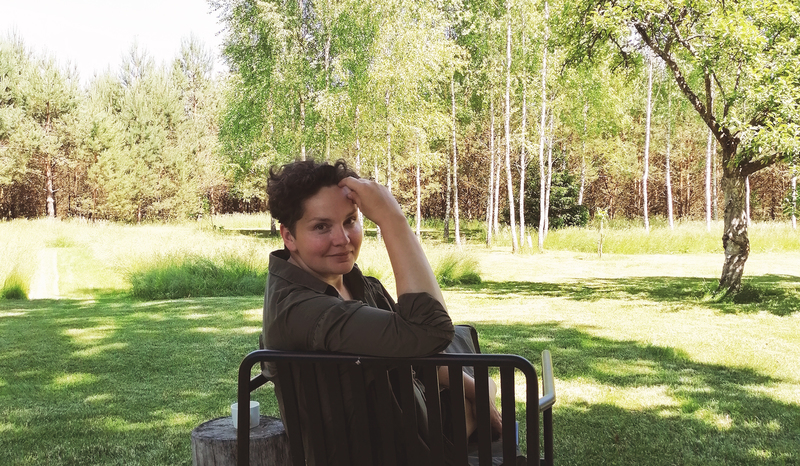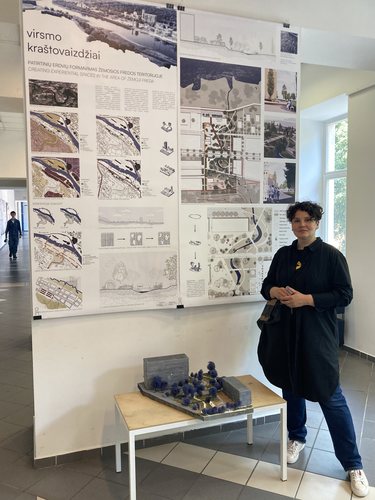Architecture
Faculty of Architecture
Latest news
Assoc. prof. G. I. Laukaitytė-Malžinskienė: "Coexistence with nature - a condition for survival"

2024-10-19
Assoc. prof. G. I. Laukaitytė-Malžinskienė: "Coexistence with nature - a condition for survival"
International Landscape Day is celebrated on 20 October, on the occasion of which an exhibition of the best European landscape architecture projects of the International Federation of Landscape Architects (IFLA) was opened on the 4th floor of the Faculty of Architecture of Vilnius Gediminas Technical University (VILNIUS TECH), open until December 2024.
According to VILNIUS TECH Associate Professor Giedrė Ingrida Laukaitytė-Malžinskienė, landscape architects are able to understand the causes of landscape change, to envisage long-term and integral perspectives of local landscapes and to form cohesive and vibrant urban spaces. "Landscape quality is an important prerequisite for survival. The human being is at the centre of a landscape architect's work, but as landscape architects we are not looking for a relation with nature, but for coexistence," says the associate professor.
In Lithuania, the Union of Landscape Architects was founded in 1995, and in 2000 the European Landscape Convention was signed, based on which it is generally acknowledged that landscape is a complex object of cultural, ecological, environmental quality and social significance to society. The fields of debate on landscape and landscape architecture are very broad, although landscape studies and projects have been carried out in the last century.
In the autumn, the special issue of DOCOMOMO, dedicated to landscape architecture in the 20th century, was published. One of the chapters was written by G.I. Laukaitytė-Malžinskienė: "The main change is that the methods used in the field of landscape architecture research, planning and design are now becoming essential and supportive in achieving the goals of sustainable urban development, and that the understanding of the city as landscape is a condition for the development of a stable entity".
In Europe, the first schools of landscape architecture emerged in Norway and Germany, and in 2000 it was decided to build on the former association of schools of landscape architecture by creating ECLAS (European Council of Landscape Architecture Schools). The thematic network project "Le:Notre" was also launched immediately after the signing of the European Landscape Convention and became the LE:NOTRE Institute, which operates as part of ECLAS and seeks to develop interdisciplinarity in landscape architecture.
On the basis of these initiatives, the Landscape Architecture study programme was developed at VILNIUS TECH. This year VILNIUS TECH congratulated the first bachelors in Landscape Architecture and only this year the Master program in Landscape Architecture has started. "Our first Master students are special. I keep telling them that you have to defend your professional qualification with your work, projects and in the future contribute to the creation of the legal framework in Lithuania," shares G. I. Laukaitytė-Malžinskienė.
Until the European Landscape Convention in 2000, there were aspects of landscape relevance integrated into other legal acts, but it is in the last decades that a multi-layered approach, bringing together many different specialists working for a quality of environment and the relationship between the man and nature, has been consistently developed.
DOCOMOMO's issue "Landscape Architecture and Infrastructure of the Twentieth Century" can be found at this link.
Photos: personal archive of G. I. Laukaitytė-Malžinskienė.
According to VILNIUS TECH Associate Professor Giedrė Ingrida Laukaitytė-Malžinskienė, landscape architects are able to understand the causes of landscape change, to envisage long-term and integral perspectives of local landscapes and to form cohesive and vibrant urban spaces. "Landscape quality is an important prerequisite for survival. The human being is at the centre of a landscape architect's work, but as landscape architects we are not looking for a relation with nature, but for coexistence," says the associate professor.
In Lithuania, the Union of Landscape Architects was founded in 1995, and in 2000 the European Landscape Convention was signed, based on which it is generally acknowledged that landscape is a complex object of cultural, ecological, environmental quality and social significance to society. The fields of debate on landscape and landscape architecture are very broad, although landscape studies and projects have been carried out in the last century.
In the autumn, the special issue of DOCOMOMO, dedicated to landscape architecture in the 20th century, was published. One of the chapters was written by G.I. Laukaitytė-Malžinskienė: "The main change is that the methods used in the field of landscape architecture research, planning and design are now becoming essential and supportive in achieving the goals of sustainable urban development, and that the understanding of the city as landscape is a condition for the development of a stable entity".
In Europe, the first schools of landscape architecture emerged in Norway and Germany, and in 2000 it was decided to build on the former association of schools of landscape architecture by creating ECLAS (European Council of Landscape Architecture Schools). The thematic network project "Le:Notre" was also launched immediately after the signing of the European Landscape Convention and became the LE:NOTRE Institute, which operates as part of ECLAS and seeks to develop interdisciplinarity in landscape architecture.
On the basis of these initiatives, the Landscape Architecture study programme was developed at VILNIUS TECH. This year VILNIUS TECH congratulated the first bachelors in Landscape Architecture and only this year the Master program in Landscape Architecture has started. "Our first Master students are special. I keep telling them that you have to defend your professional qualification with your work, projects and in the future contribute to the creation of the legal framework in Lithuania," shares G. I. Laukaitytė-Malžinskienė.
Until the European Landscape Convention in 2000, there were aspects of landscape relevance integrated into other legal acts, but it is in the last decades that a multi-layered approach, bringing together many different specialists working for a quality of environment and the relationship between the man and nature, has been consistently developed.
DOCOMOMO's issue "Landscape Architecture and Infrastructure of the Twentieth Century" can be found at this link.
Photos: personal archive of G. I. Laukaitytė-Malžinskienė.
-
- Page administrators:
- Agnė Vėtė
- Karolina Kardokaitė



